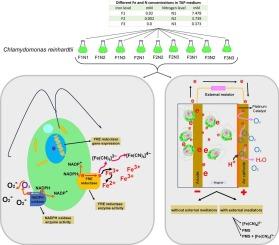Exoelectrogenesis response of Chlamydomonas reinhardtii in biophotovoltaic cells under iron and nitrogen deficiencies
IF 4.5
2区 生物学
Q1 BIOTECHNOLOGY & APPLIED MICROBIOLOGY
Algal Research-Biomass Biofuels and Bioproducts
Pub Date : 2025-09-11
DOI:10.1016/j.algal.2025.104301
引用次数: 0
Abstract
The green microalga Chlamydomonas reinhardtii is a model organism for bioelectrogenic studies under nutrient stress, yet its exoelectrogenic behavior under iron and nitrogen deprivation remains underexplored. In this study, C. reinhardtii strain cw15 (cell wall deficient) was cultivated under nine defined media conditions with varying concentrations of FeCl₃ (0.02, 0.002, and 0 mM) and NH₄Cl (7.48, 3.74, and 0.374 mM). After four days of growth, cells were transferred to custom-built, single-chamber air-cathode biophotovoltaic (BPV) devices to evaluate voltage generation in the presence and absence of external electron mediators, including ferricyanide (FeCN), phenazine methosulfate (PMS), and their mixture. In the presence of FeCN the highest closed-circuit voltage (57 mV) was observed under iron starvation (0.0 mM FeCl₃) with full nitrogen supply. In contrast, the PMS-FeCN mixture yielded the highest output (121 mV) under combined Fe and N limitation. Polarization and mediator assays confirmed that the greatest electrogenesis rate (970 μW.m−2), 2.5 times that of the control, occurred in cells under Fe deficiency with moderate N supply, in the absence of any external mediators. These findings were verified by sodium 3′-[1-(phenylaminocarbonyl)-3,4-tetrazolium]-bis(4-methoxy-6-nitro) benzene sulfonic acid hydrate (XTT) and ferricyanide reduction assays, suggesting enhanced electron release capacity under nutrient stress.

缺铁缺氮条件下莱茵衣藻在生物光伏电池中的产电响应
绿微藻莱茵衣藻(Chlamydomonas reinhardtii)是研究营养胁迫下生物产电的模式生物,但其在缺铁和缺氮条件下的产电行为尚不清楚。在这项研究中,用不同浓度的FeCl₃(0.02、0.002和0 mM)和NH₄Cl(7.48、3.74和0.374 mM)在9种确定的培养基条件下培养C. reinhardtii菌株cw15(细胞壁缺陷)。生长4天后,将细胞转移到定制的单室空气阴极生物光伏(BPV)装置中,以评估在存在和不存在外部电子介质(包括铁氰化物(FeCN),非那嗪甲硫代硫酸盐(PMS)及其混合物)的情况下电压产生情况。在FeCN存在的情况下,在缺铁(0.0 mM FeCl₃)和全氮供应下观察到最高的闭路电压(57 mV)。相比之下,PMS-FeCN混合物在Fe和N组合限制下产生了最高的输出(121 mV)。极化和介质实验证实,在缺铁和中等氮供应条件下,在没有任何外部介质的情况下,细胞的产电速率最高(970 μW.m−2),是对照的2.5倍。通过3 ' -[1-(苯基氨基羰基)-3,4-四唑]-双(4-甲氧基-6-硝基)苯磺酸水合物(XTT)和铁氰化物还原实验验证了这些发现,表明营养胁迫下电子释放能力增强。
本文章由计算机程序翻译,如有差异,请以英文原文为准。
求助全文
约1分钟内获得全文
求助全文
来源期刊

Algal Research-Biomass Biofuels and Bioproducts
BIOTECHNOLOGY & APPLIED MICROBIOLOGY-
CiteScore
9.40
自引率
7.80%
发文量
332
期刊介绍:
Algal Research is an international phycology journal covering all areas of emerging technologies in algae biology, biomass production, cultivation, harvesting, extraction, bioproducts, biorefinery, engineering, and econometrics. Algae is defined to include cyanobacteria, microalgae, and protists and symbionts of interest in biotechnology. The journal publishes original research and reviews for the following scope: algal biology, including but not exclusive to: phylogeny, biodiversity, molecular traits, metabolic regulation, and genetic engineering, algal cultivation, e.g. phototrophic systems, heterotrophic systems, and mixotrophic systems, algal harvesting and extraction systems, biotechnology to convert algal biomass and components into biofuels and bioproducts, e.g., nutraceuticals, pharmaceuticals, animal feed, plastics, etc. algal products and their economic assessment
 求助内容:
求助内容: 应助结果提醒方式:
应助结果提醒方式:


